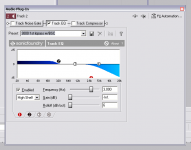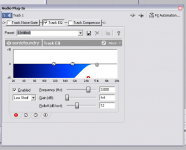Ive been thinking of a way to do this for a few weeks but didnt have a good enough reason to disasemble one of my speakers until today...
Its not easy to pick a crossover freq and slope that will work best for drivers until you hear them. Even based on previous knowledge and good math, sometimes you still need to filddle with the xo. And if you dont, part of you wonders, 'Is this the right one? Can I do better? Should I spend lots of money on extra xo parts to find the right one?'
So... Insted of ordering a butt load of crosover parts I figured a way to test slopes and freq and even implement BSC all with my PC. I fired up Vegas and inserted an audio track, copyed it to the next track, switched each track to summed and pan each one 100%L and 100%R. On each track I used the 4 band ParaGraphic EQ to simulate a crossover. One band for the crossover and one for BSC (on the woofer only). I then took apart my w4-656 based speakers and connected wires directly to the drivers and ran them out of the dual ports on the back. It was kinda scary hooking the tweeter directly up to the output of my amp. I had to use great catuion to be sure I panned the tracks corectly and started with low volume.
It was intresting to play with the two freq and change the slopes in real-time. You can really get an understanding of the relationship between the two and how they affect the system as a whole. Now sure, guys out there with these expencive active xo's are saying 'duh!' But I dont want an active xo for every audio system in my house. Nor could most of us afford such. So this is for discovery mostly... and its fun.
Its not easy to pick a crossover freq and slope that will work best for drivers until you hear them. Even based on previous knowledge and good math, sometimes you still need to filddle with the xo. And if you dont, part of you wonders, 'Is this the right one? Can I do better? Should I spend lots of money on extra xo parts to find the right one?'
So... Insted of ordering a butt load of crosover parts I figured a way to test slopes and freq and even implement BSC all with my PC. I fired up Vegas and inserted an audio track, copyed it to the next track, switched each track to summed and pan each one 100%L and 100%R. On each track I used the 4 band ParaGraphic EQ to simulate a crossover. One band for the crossover and one for BSC (on the woofer only). I then took apart my w4-656 based speakers and connected wires directly to the drivers and ran them out of the dual ports on the back. It was kinda scary hooking the tweeter directly up to the output of my amp. I had to use great catuion to be sure I panned the tracks corectly and started with low volume.
It was intresting to play with the two freq and change the slopes in real-time. You can really get an understanding of the relationship between the two and how they affect the system as a whole. Now sure, guys out there with these expencive active xo's are saying 'duh!' But I dont want an active xo for every audio system in my house. Nor could most of us afford such. So this is for discovery mostly... and its fun.
...and this is the eq for the tweeter. 2nd order 3kHz . I tried these values to see if a lower freq xo would have sounded better than the 6500Hz 1st order series xo I currenly use. I found that even if I use the values of my current crossover into this setup I get something real close to what I have implemented pasively. The series xo still sounds smoother than active. A little foward but smoother. I figure it is because my pasive xo has a zeta of 1 ( I used Butterwoth values). So this method probably should not be used to figure exact parts but it makes it a lot easier to find a starting point.
Chris
Chris
Attachments
Neat! As you say, there nothing better then trying the real thing in real time. My experience with the DCX2496, but you already mentioned those stand anlone things.
I have one question. How is the phase response of these virtual xovers wrt a real C/R/L one? For instance, on the DCX, I can realise xovers with zero phase shift, something I couldn't do with C/R/L ones. Would that make the'm sound (much) different?
Jan Didden
I have one question. How is the phase response of these virtual xovers wrt a real C/R/L one? For instance, on the DCX, I can realise xovers with zero phase shift, something I couldn't do with C/R/L ones. Would that make the'm sound (much) different?
Jan Didden
- Status
- This old topic is closed. If you want to reopen this topic, contact a moderator using the "Report Post" button.

